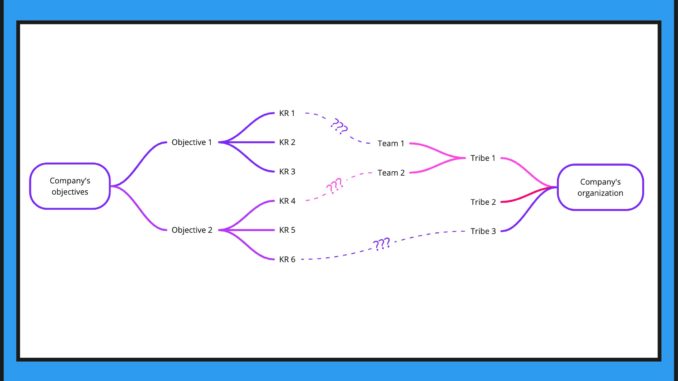
Here is a speech I made for a client’s board who’s willing to improve their objective setting at team and individual level. That client (let’s call him The World Company – TWC) is currently transforming its organization to be more agile, meaning to be able to work on what matters, to be able to pivot if needed and to learn from failures. It has adopted a matrix organization inspired from the Spotify model, so you may see notions like tribes and chapters.
I don’t go into the details of OKRs and portfolio management because the attendance already knows about it.

OKR stands for Objective and key result.
- It’s a way to describe the company’s strategy for the next 12 months. But as we’ll see later, we don’t set objectives for a year and cross fingers hoping someone will take care of them. Objectives are regularly assessed by measuring the status of key results : we’re going to measure what matters
- The main impact is that teams’ daily work will be fully aligned with the company’s stakes. Each time a new feature is started, the developers know how it’s going to impact TWC’s economics and why they need to do it. It gives more sense to our work which leads ofter to a better motivation
So let’s take an example of one OKR. TWC wants to become the leader on their market in the next 12 months. The objective is explained in a simple sentence, it is SMART but ambitious. How is the company going to explain employees how they see the success of this mission ?
- The 1st key result is to increase sales by 10%. It is a good KR because it is measurable and because it is a consequence of what people will do : employees can’t change the status of the key result directly. They can’t cheat and make the bride more beautiful than she is 🙂
- But what happens if the sales people are tempted to use bad manners to force the sales ? Just to get their bonus ? That’s why we created Key Result n° 2. This KR is to counter balance a potential negative effect of KR 1. That way, Sales people will know that increasing the sales is OK only if customers are happy
- Some Key results may sometimes seem contradictory. But it is on purpose. Because people will start thinking differently from an OR mindset to an AND mindset. It fosters collective intelligence, and disruptive ideas may pop out. For example : how can we reduce the infrastructure costs by 10% AND improve our quality of service by 20% ? It’s a wicked question.
- The last key result, KR3 – One new brand for young people, is a bad one. Do you know why ? Because it is just an item in a todo list. We tell people what to do. It’s more an initiative (from a portfolio management standpoint) than a key result.
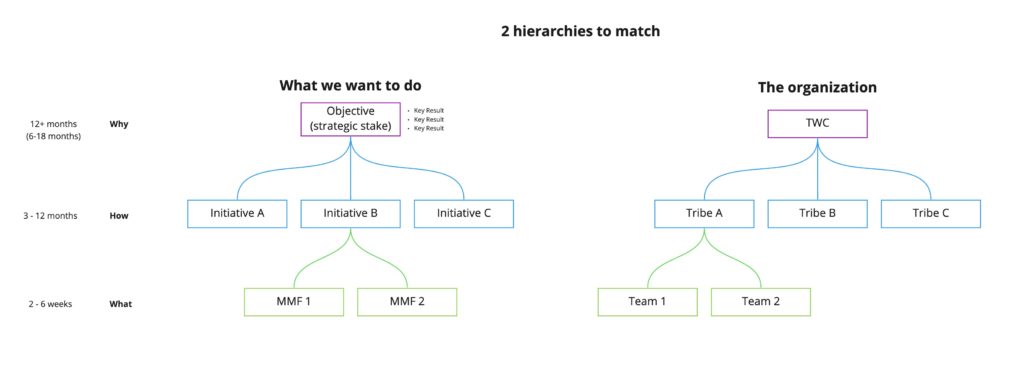
When an organization uses portfolio management, OKRs are a good way to match the portfolio items hierarchy with the organization’s hierarchy. In fact, who’s going to do what and why ? On the left, we have the portfolio items, starting with the strategic stakes. They are described in an OKR way. It is the “why we need to make a move ?”. Then the initiatives, which are the “how we can impact the company and its customers to reach those objectives ?”. And then the features, which are the “what we’re concretely going to do ?”On the right, we have the new organization based on the Spotify model. So the question is : “how do we match those 2 hierarchies ?”
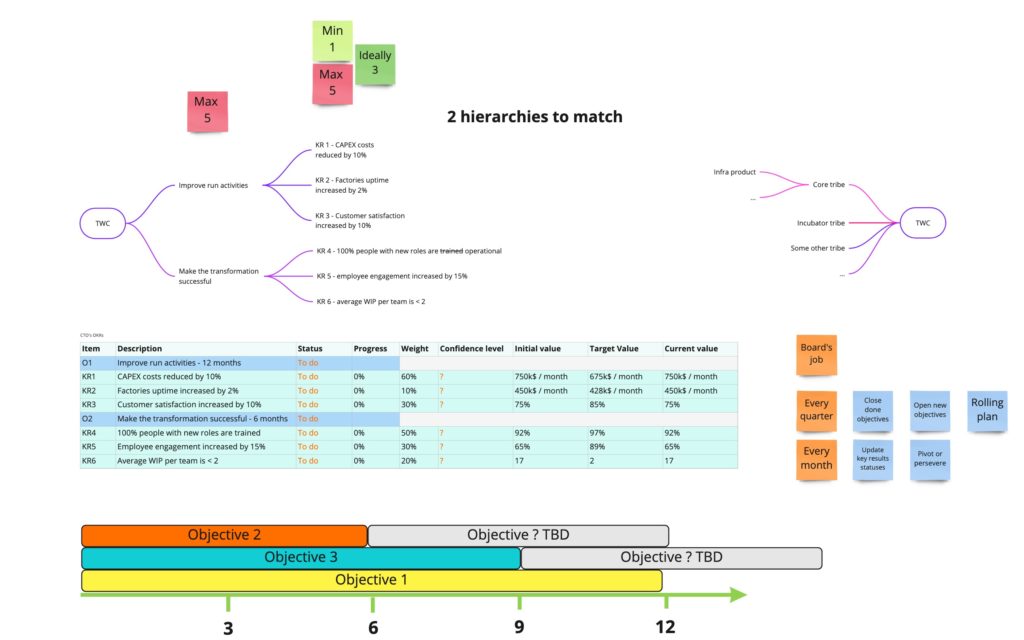
First, the board is going to work, and it’s the most sensitive part because the whole organization will be driven by a few words and numbers for a whole year. That’s why we need to pay attention to what we say and how we plan to explain it. So, the board defines a few objectives (max 5) with a few key results each (between 1 and 5, ideally 3). I created a short example to show you how it could look like. The main deliverable of this phase is a table listing the objectives and the key results. As you see there are some important informations to provide : for each KR, we need to know its initial value. You may know today your current CAPEX costs (like in KR1), but maybe you don’t know your current factory average uptime (KR2) or your current average work in progress by team (KR6). So we need to put ourself in the position to be able to measure those KRs. At the beginning, we won’t be able to measure everything we would like to measure. But being able to measure some KR may become an objective itself.
So, as you see, the objectives don’t necessarily have the same timeframe. One is 12 months, the second 6 and the third 9. It’s ok. Because as soon as an objective is reached or ended, we’re going to launch a new one. This is the beginning of a 12 months rolling plan. We just need to be prepared to launch a new objective, because the alignment process with tribes can take some time. That way, every quarter the board closes done objectives and launch new ones. The board can also decide to extend the initial timeframe if needed. Every month, the board updates the key results to see if the teams managed to influence those numbers. If yes, good news, let’s keep going. If not, we may have to dig a little, see which initiatives are designed to work on those key results and go to the tribes or teams to see if they need help. The tribe leader may decide to stop an initiative if it doesn’t provide the expected value.
Now, let’s talk about the alignment process with tribes I just mentioned…
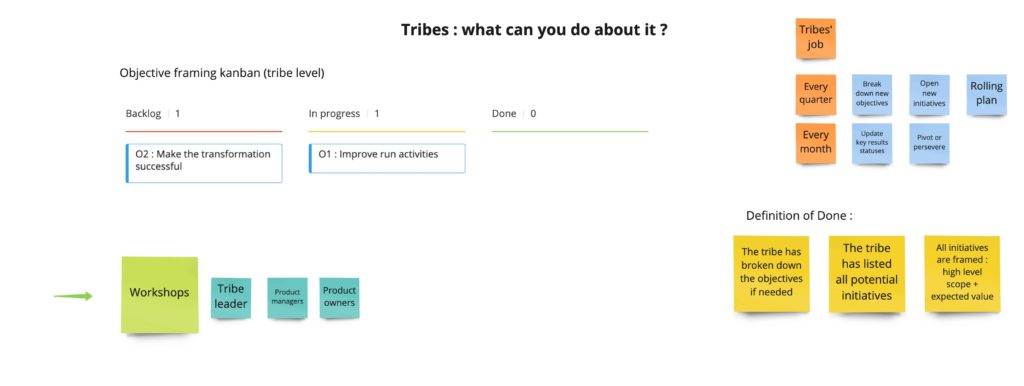
Once the table describing the OKRs is set, the board will gather every TWC member in one single meeting. The objective of this meeting is to explain what the board has in mind with those objectives. It’s also a good occasion to review closed objectives and share the results, congratulate the teams. Such meeting could happen every quarter. After explaining everything, some Q/A and after that, it’s up to each tribe to work on those OKRs and prepare their own, aligned with TWC’s. We can see that as a series of workshops inside each tribe, where tribe leaders, product managers and product owners meet to design their own OKRs and define how they plan to meet those objectives by preparing new initiatives.Then each tribe has its own kanban to frame their OKRs, which definition of done could be :
- The tribe has broken down TWC’s OKRs
- The tribe has listed all potential initiatives as answers to the objectives
- All initiatives are framed at high level with an idea of the scope and the expected value.
And we end up with something like this…

We have TWC’s OKRs on the left and TWC’s tribe organization on the right, just as before. In the middle, we can see that the Infra product has decided that to address the “Improve run activities” objective, they could have 2 objectives on their side : 1 to reduce infrastructure costs, with 2 key results (VM monthly costs reduced by 7% and License expenses reduced by 10%). And an other one to improve support with 2 key results (improve compliance with SLA and improve customer satisfaction). All those key results are meant to have an impact on the “Improve run activities” key results on the left.And how do they plan to have such an impact ? They decided to launch 2 initiatives and also to 1/ Focus more on their ways of working to improve their SLA and 2/ Send surveys to their clients to get feedbacks and adapt their behaviors accordingly.That means that this product team of teams is aligned with part of TWC’s objectives. They declare they won’t participate to other objectives.
An other tribe, TWC office, assumes that they can’t do much about improving run activities. But they claimed they could do something about making the transformation successful. As you see, I tricked myself at first when I prepared the KR4 : I started with “100% people with new roles are trained”. But that’s not a good key result : it is a todo list item ! So I changed “trained” with “operational”. Because it brings more inspiration to people. The question is wider and maybe there are other things that tribes can do about people with new roles. To leverage my mistake, I wondered “how to set people with new roles operational, beside with training sessions ?” And i got a new idea : “Of course, we could also launch a new individual coaching program to help those folks !”. I wanted to share this story with you because it shows how words are important and can have different impacts. If we give the solution to a problem, we won’t get anything else than that solution.
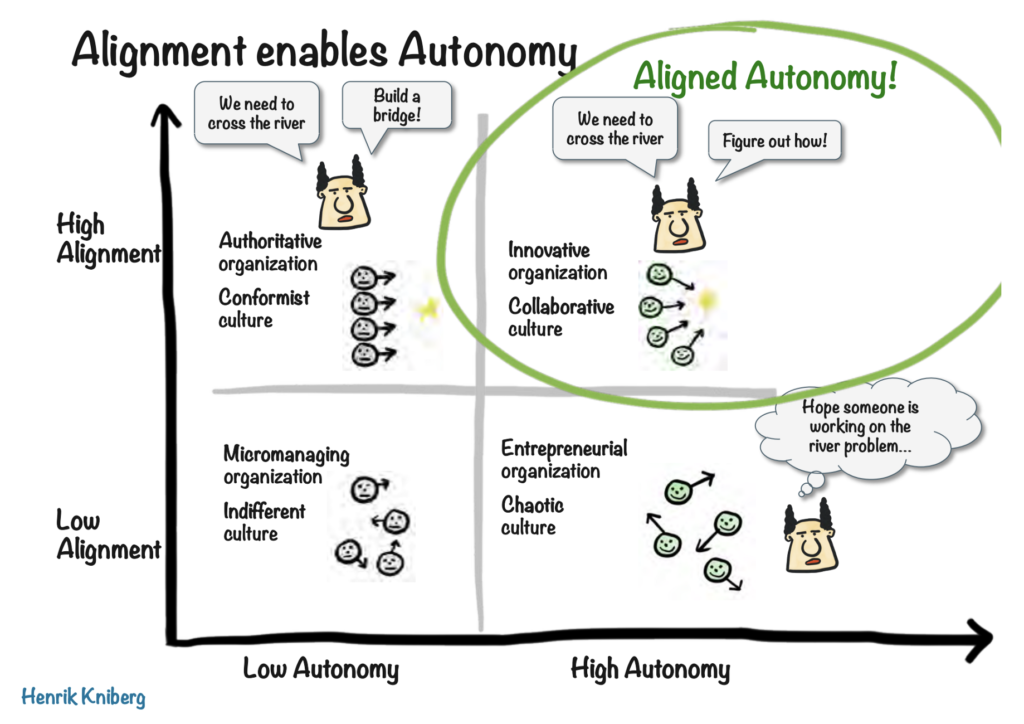
To show you what I mean, here is a drawing made by a coach who worked at Spotify 10 years ago. I love it because it’s very inspirational for me. It shows that alignment is not opposed to autonomy. On the contrary, we can benefit from the opinion of hundreds of professionals to tackle our big problems.
There is a quote by Steve Jobs that says : “It doesn’t make sense to hire smart people and tell them what to do; we hire smart people so they can tell us what to do.”
To sum up, this OKR breakdown and hierarchies matching will help the organization to ensure all objectives are taken care of and have visibility on how tribes plan to contribute. And as you see, we don’t reduce the perimeter of initiatives to technical ones only. We embrace every type of initiative, including cross tribes training plans.To go a little further, you can see that I was lazy when preparing that meeting : I should have broken down the “Make the transformation successful” OKR at the TWC Office level with key results defining what operational means for them. I should also have defined broken down OKRs at the Core tribe level before defining the Infra product OKRs. But you understand the concept.
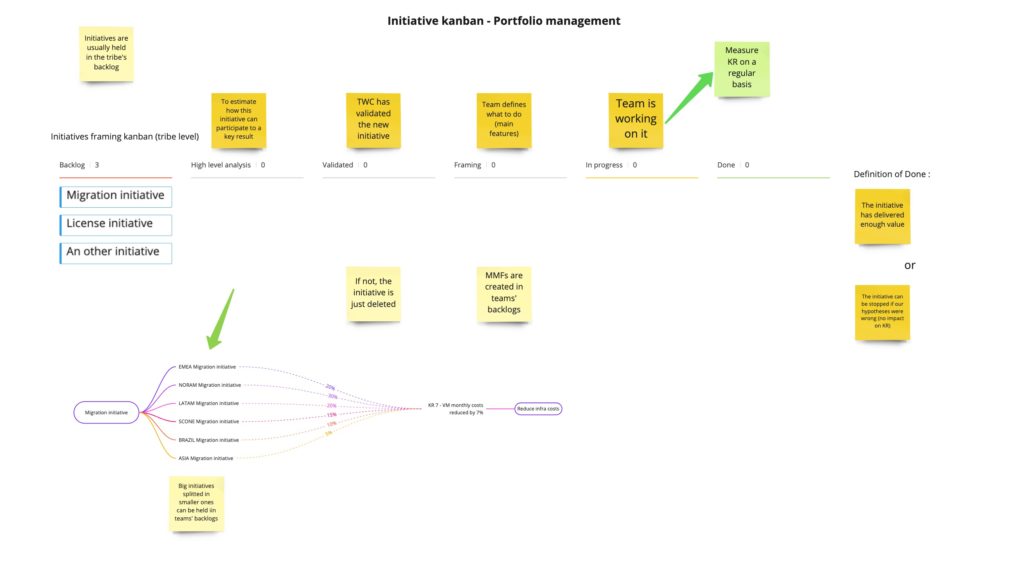
All the initiatives proposed by tribes are followed in the initiative kanban. Here is an example of a tribe’s initiative kanban but we can imagine having the same visibility at the board level.It is teams’ and tribes’ responsibility to make the initiatives and MMFs live in the system. That way, visibility is given to higher levels.In this example, the big Migration initiative in the Core tribe is really big and the teams need to estimate the possible impact on KR7 – Reduce infrastructure costs. To do that, The big initiative is splitted in smaller ones, one for each involved teams. It is doable because there are no dependancies. They all work on their side to estimate the number of servers to migrate, and when the tribe leader consolidates, we get an idea of the total duration, value and how we plan to contribute to TWC’s KR.

We saw that TWC produced a table describing their OKRs. When tribes have done their job by breaking down OKRs and proposing initiatives, they also create and maintain their own table.
Let’s talk quickly about individual objectives. Because for the moment we designed tribes’ and teams’ objectives. That means that a high percentage of the objectives will be collective ones. But sometimes we’ll need to drive some objectives to specific roles or people.
Let’s go back to KR6 – Average WIP per team is less than 2. Is there any initiative you can think of ? We can then decide, at the board level, that all tribe leaders, product managers and product owners will have that objective individually. This is not John Doerr by the book, but it is a possibility.
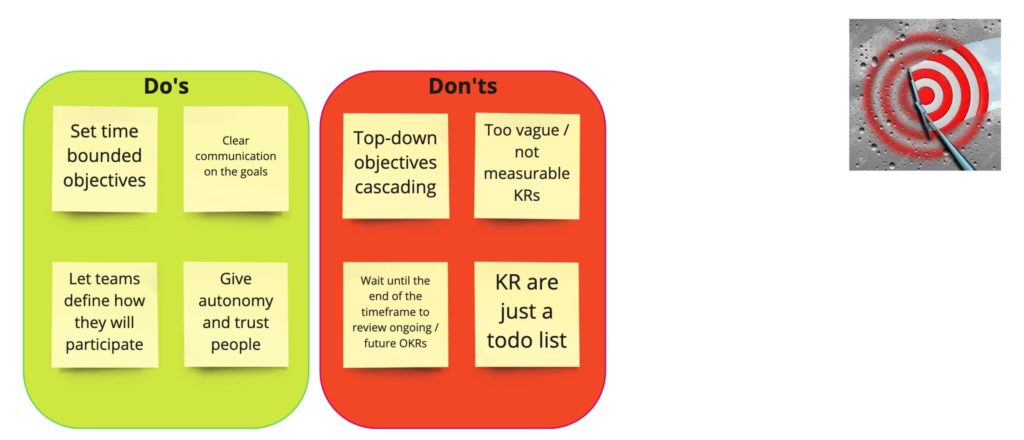
To conclude, let’s review some do’s and don’ts together.
For the do’s :
1/ First, objectives should be time-bounded. That doesn’t mean it is a commitment to achieve the goal in that time frame. But this is the equivalent of the money we are ready to spend regarding the outcomes we target. We’ll be free to extend the frame for an extra quarter later if we think it is needed. We can also decide to close the objective before the end of the timeframe if, for example, we achieved 95% of the key results in 3 quarters out of 4. Maybe it is not a good economical choice to spend the other quarter getting the last 5%. Let’s then open a new objective with other great outcomes.
2/ Second, we need to communicate clearly on the objectives. They must be well understood because a lot of decisions are taken close to the field. And those decisions will be driven by the words you chose and the explanations you made.
3/ Third, let the teams define how they will participate to the objectives. Because you may have some ideas on how teams should impact the business and customers. And you may have right. But there are 500 brains that will be focused on how to cross that river, there might be a little chance they have ideas you couldn’t think of. And also that drives a better motivation on a daily basis if we let people choose how they want to impact the company. But don’t worry, if your ideas don’t come in what people intend to do, you’ll still be able to influence the result. Because you’re still the boss 🙂
4/ Fourth, give autonomy and trust people. People don’t need to be micro-managed. If they have a clear guidance due to well defined OKRs, then they’re going to go in the right direction. And we have key results as guardrails if needed.
For the don’ts :
1/ First : top-down objective cascading often lead to predefined roadmaps with a forced commitment imposed to the teams.
2/ Second : Too vague or not measurable key results lead to vague and poor results. We need to pay attention to what we measure because it is what is going to be impacted.
3/ New potential OKRs must always be ready if we decide to close an objective sooner that planned. Because if we close an objective without opening a new one, we lose the opportunity to bring more value quicker.
4/ Fourth, key results as tasks is just people telling what to do. That breaks any innovative initiative
